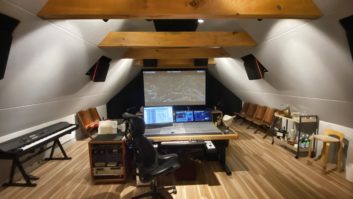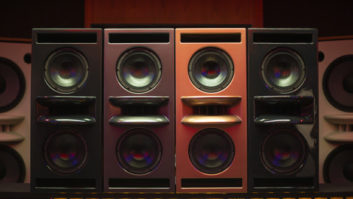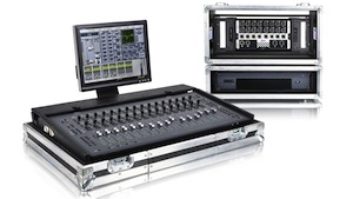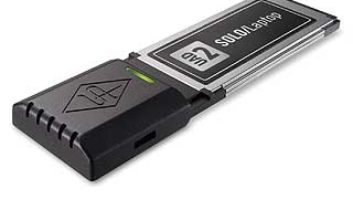
Photo: www.shutterstock.com
It’s rare that the terms “pro audio” and “turmoil” are used in the same sentence. However, during the past 18 months, the wireless pro audio world has been in turmoil over the changes that will result from the FCC’s frequency re-allocations that will take effect on February 19, 2009. Several different issues are in play simultaneously, the latest of which is that the U.S. Congress is contemplating a bill that would open up what are considered by many to be the “unused” portions of the frequency spectrum — aka, white spaces — for broadband use. The pro audio wireless industry faces a daunting challenge in maintaining its ability to run large-scale productions that rely heavily upon wireless equipment. Even as Mix prepared this article, new developments were literally happening on a daily basis.
A Quick History
Although licenses are required for wireless microphones, wireless audio gear transmits at very low power levels (averaging 50 milliwatts and maxing out by law at 250 mW). Add to that the fact that wireless mics do not broadcast 24/7 and that the FCC has basically ignored that there are millions of wireless mic users as opposed to the many other types of RF devices.
The licensing requirement was originally created as a means of tracking down cases of interference between wireless mic signals and TV broadcasts, but such problems never appeared. With decades of successful spectrum-sharing between wireless audio and TV broadcast, the FCC never set aside a specific UHF band for wireless mic applications as it has for aircraft communications, radio and TV broadcasting, cell phones and public-safety communication purposes. James Stoffo — who is frequency coordinator for the NBA All-Stars and Finals broadcasts, the Latin Grammy Awards and Billboard Latin Music Awards, and an entertainment RF technician for the Super Bowl — estimates that there are between a half-million and a million wireless mics in the U.S., but that fewer than 1,000 are licensed by the FCC.
Full-power, terrestrial analog broadcast television is scheduled to cease in the U.S. in February 2009, which means that analog TV will be obsolete and that the frequencies formerly used for analog TV will become available for other uses. This gives the illusion that there will be a lot of bandwidth available for competing technologies, but this is not the case.
Prime Real Estate
Lectrosonics’ director of business development, Karl Winkler, reminds us that many people desire the UHF band for the same reasons. “The UHF band between 500 and 800 MHz offers excellent wave-propagation characteristics, as well as practical antenna size,” he says. “UHF can transmit over long distances with relatively low power. As frequencies get higher, it takes more energy to transmit the same distance and the wave is less able to penetrate through or bounce around objects. A ¼-wave antenna is very efficient for a UHF device, and at around three inches long that’s very attractive. When you get into the frequency range higher than 1 GHz, antenna length can be even shorter, but you begin to lose the desirable propagation characteristics of UHF.”
Here Comes the Big Bad Wolf
Three major issues face pro audio wireless, two of which are already facts of life. The first is known as the “digital dividend.” Joe Ciaudelli, Sennheiser USA’s consultant for professional products, explains, “The digital dividend is the re-allocation of the frequencies between 698 and 806 MHz, corresponding to UHF channels 52 through 69. Right now, television broadcasters are transmitting both analog and DTV signals. That ends in February of 2009, and when the analog channels are shut off, all TV broadcast will be consolidated below channel 52. This gave the government the ability to auction off channels 52 through 69. Verizon and ATT submitted winning bids on this spectrum, allowing them to secure these frequencies for a new class of consumer service after February 2009. This is a huge windfall for the government — they raised $19 billion. They were able to do this because DTV channels can be placed right next to each other, whereas analog channels required guard bands to prevent interference. When analog transmission ceases, DTV channels will be pushed closer together, freeing up the space from UHF 52 to 69. That is already a done deal.”
Stoffo elaborates on the second issue. “Strike two is the fact that a DTV channel is a complete 6MHz-wide burst of energy, and you cannot fit anything else inside it. If you picture a window of 6MHz spectrum, you can have an analog TV station in that space with one strong picture carrier and a separate sound carrier. Then, depending upon the strength of the TV station, you could also fit a couple of wireless microphones or in-ears in the white spaces [unused portions] of that window. DTV completely fills that window, so you must vacate that band entirely. This is why we are losing so much operational capability.
“Since 1962, we have had from 470 MHz to 806 MHz available for wireless microphone use — that’s around 330 MHz of bandwidth,” Stoffo continues. “We lost 108 MHz of that bandwidth due to the auctions, and with DTV broadcast firing up, we lost half the remaining spectrum. The result is that we have approximately one-third of the bandwidth that was formerly available. A production like the Super Bowl requires around 1,500 RF microphones and we’ll use close to 2,000 different frequencies. Trying to fit that into one-third of the bandwidth is going to be very difficult, if not impossible.”
The potential strike three, which Stoffo calls “the final nail in the coffin,” is legislation that the government is currently considering. “White space legislation — which has not yet happened — would open up the ‘unused’ UHF TV channels for broadband use,” reports Mark Brunner, Shure’s senior director of public and industry relations. “That is why the FCC has been conducting tests on proposed white-space devices.”
During the summer of 2008, at the request of the Senate and the House of Representatives, the FCC began conducting field trials of proposed white-space devices. In theory, an approved white-space device would scan the local RF spectrum when turned on, identify the frequencies that are already in use and then choose a vacant frequency for its own operation. On August 9, 2008, the FCC attended a pre-season NFL football game in Washington, D.C., at FedEx Field. Prototype white-space devices were turned on and failed to scan the RF spectrum accurately for active wireless mics or TV channels. They also caused interference with the wireless mics already in use and failed to consistently recognize wireless mics that were turned on during the course of the game.
On August 11 and 12, FCC engineers attended test sessions at the Majestic Theater in New York City for prototype white-space devices submitted to the FCC for approval by electronics manufacturers Philips and I2R. (RF devices require FCC approval to be sold in the U.S.) Again, the devices failed. “The two devices had opposite problems,” reveals Brunner. “The Philips unit detected everything and the I2R detected nothing. By ‘everything,’ I mean that its interface showed no vacant spectrum. Discerning a microphone when you believe all channels are occupied is a moot point. The I2R device, on the other hand, simply failed to detect any of the wireless microphones, even from the tenth row of the theater.
“It was a real eye-opener for FCC engineers to see the level of RF activity, and it validates what we have been saying throughout the entire proceeding: It would be a mistake to create technical rules regarding white-space devices without understanding exactly what is happening in the operating environment,” Brunner adds.
Where Do We Go From Here?
The results of the FCC trials will be compiled and reported to the U.S. House of Representatives and the Senate, but as Ciaudelli points out, “This does not guarantee that the politicians will make an objective decision. The FCC engineers are being very thorough and scientific about their approach, and they will make recommendations, but they do not legislate. We do hope that the politicians evaluate the data in the same impartial manner that the FCC engineers gathered it rather than be swayed by lobbying dollars. There is a lot of money at stake, and companies like Google, Microsoft, Intel and Dell have significantly more lobbying resources than the pro audio industry.”
Users of pro audio wireless systems are already facing the fact that they may have wireless gear operating on frequencies between 698 and 806 MHz — those channels that were auctioned. “Lectrosonics has gone into a ‘special-order’ status for products operating in the 700MHz band,” notes Winkler. “After the end of this year, we will no longer manufacture products for the U.S. market in that band. To compensate for that loss of bandwidth, we added three frequency blocks at the bottom end of the UHF band in the range from 470 to 538 MHz. We also added a block high above this range at 944 MHz, so if you were running a lot of wireless microphones and needed to squeeze in two more IFB channels, that would be a place to do it.”
According to Brunner, “Shure has been working with our major accounts to help transition inventory away from wireless systems in the 698 to 806MHz band. Exactly what rules will be in place post-DTV transition — which is when this spectrum is available for use by the new parties — has yet to be determined and will be discussed at the August 22 Commissioner’s meeting at the FCC. Hopefully, we’ll get some clarity from that meeting, but it is clear to all wireless manufacturers that this is no longer a usable spectrum.”
Ciaudelli agrees: “The inability to use the 700MHz band definitely makes our lives a little more complicated. As time goes on, it will be more difficult to predict reliable operation of wireless microphones in the spectrum between 698 and 806 MHz. There is also the possibility that the FCC will change their regulations and restrict use of wireless microphones in that spectrum. Until they make that proposal, I do not want to induce fear in people, but since last year we have been telling our customers who desire to add more wireless channels to their systems [to] opt for channels operating below that range.”
As we spoke with Stoffo, he was at the Pepsi Center in Denver, prepping for the Democratic National Convention. “A third or more of the RF that I am seeing in this building is above 698 MHz, which will be unusable after February 2009. After that time, companies like Motorola and Qualcomm will be firing up high-powered devices in that band, for which they paid billions of dollars. If they experience disrupted service because of your wireless microphones, they could take legal action against you.”
Brunner is optimistic that the FCC will not shut wireless mic users out of the white space below 698 MHz. “It’s more a question of whether the FCC will allow this new class of devices to share the same spectrum that we use for our wireless microphones.” Ciaudelli adds: “Our contention is that major news and entertainment events would not be able to provide the same production quality if the spectrum was randomly flooded with interference from these new devices.”
“It appears to me that the FCC is being muscled by large corporations to push through approval of these devices even though they are failing the tests,” Stoffo says. “One telecommunications corporation makes more profit than the entire audio industry combined, and that may influence the decisions unfavorably. If that means you can’t enjoy a Broadway musical or a football game, it will change the culture of America. It could also translate into a safety issue. In the case of Cirque du Soleil, I installed most of the backstage communications. What if someone is going to be jumping off a platform 90 feet in the air and that net is not in place? If you cannot communicate that to the person calling the show, someone may get hurt.
“I think that the FCC is going to approve the products, we’ll have a couple of catastrophic events and then everyone will realize that the FCC messed up,” Stoffo continues. “The one relief I see in this is that there will be a short period of time [starting from February 17 until the white-space devices are introduced] when my job will actually get easier. A major market has about 15 analog stations representing 90 MHz of spectrum. If they turn off the analog stations without immediately replacing them with white-space devices, I’ll certainly be using that space for my wireless equipment. I anticipate that to last about a year until the white-space devices are introduced and then, of course, it is all up in the air.”
Brunner acknowledges an “unyielding desire of broadband technology manufacturers to get their hands on the UHF band. There is a relentless drive to pursue this technology and there has been discussion of alternative approaches. Motorola is talking about ‘geolocation’ as the key to making this work, or possibly deploying beacon transmitters to protect wireless microphones.
“A beacon transmitter communicates frequency information to a portable device and directs it to stay off a particular channel,” Brunner explains. “It would put out a signature that is more easily recognized by the white-space device, perhaps containing data that says ‘545.7 is occupied. Stay off it.’ That sounds wonderful, but the device has to sense the beacon and we still have the same problems: multipath, overshadowing by strong DTV signals. Plus, the beacon itself requires spectrum so it’s almost counterproductive. If a portable device knows what city it is in by virtue of geolocation, it could be given access to a data table of what TV channels are on air in that market. That’s fine, but what about wireless microphones? Where is that database and who is managing it? Who has access to it? How do you account for every wireless microphone in the U.S. when they are not licensed? You can’t. It is a brutal proposition.
“The pro audio industry needs to remain vigilant about the hurdles that must be cleared,” Brunner concludes. “I think that as these technologies continue to prove difficult, it almost forces the issue that we need spectrum dedicated for use of wireless microphones. Aaron Hartman, an RF engineer at Shure, has been the spearhead of this effort for our company, and he breaks it down pretty easily when he says, ‘Good fences make good neighbors.’”
In addition to being Mix‘s sound reinforcement editor, Steve La Cerra is the front-of-house engineer for Blue Öyster Cult.






